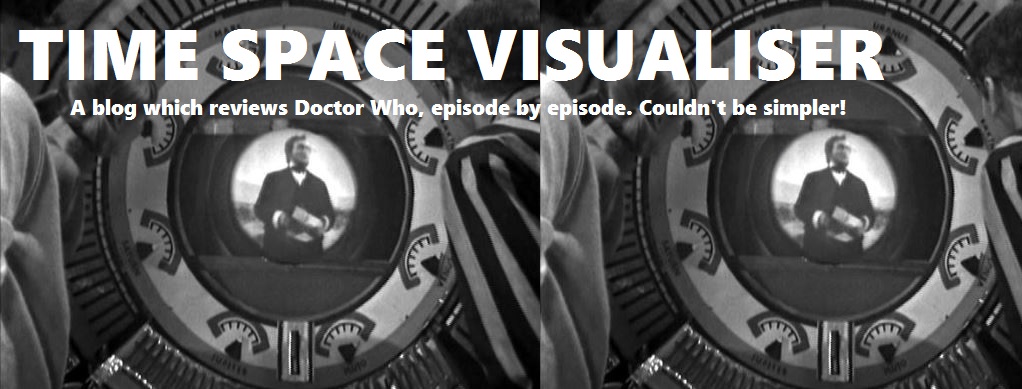The one where Jamie makes a new friend...
Episode 4 is basically The Trials of Jamie McCrimmon, as a big chunk of it is taken up with action-based scenes of the Highlander either fighting with Kemel, or surviving various deadly traps. Action and fight scenes are never very much fun on audio, so the opening fight between Jamie and Kemel makes for arduous listening, although I'm sure it looked great. The same goes for the closing scene of Jamie and Kemel climbing up the rope to the minstrel's gallery to rescue Victoria - with just the sound to guide us, it loses all jeopardy.
The bond that develops between the Scot and the Turk is a nice touch though, especially after Jamie rescues his would-be killer from a fatal fall from the window. Kemel then returns the favour by saving Jamie from a falling axe, and the two soon become firm friends. It's a pity such a prominent black character has to be a mute brute, but at least Season 4 has shown efforts in casting non-white actors (Elroy Josephs, Earl Cameron, Paul Anil and Mark Heath spring to mind) - it's just that they're rarely strong, principal characters.
By far the most interesting, and best written, dynamic of the episode is that between Edward Waterfield and Theodore Maxtible. Whitaker writes Waterfield very believably, and John Bailey performs the Victorian gentleman with great sensitivity and empathy. Waterfield is deeply affected by the death of a fellow human being, whether that's Kennedy or Toby (who he doesn't know personally). The way human life is being wasted and devalued horrifies Waterfield, whereas Maxtible sees it all as a means to an end - whether that's the Daleks' end or his own. Waterfield finds himself surrounded by horrors, and has the fabulous line: "There's no end to this... The hands of the devil!"
There's an exchange about responsibility - Waterfield feels he is indirectly responsible for the deaths of Kennedy and Toby, as a "silent partner", but Maxtible insists they had no part in these bad deeds and cannot blame themselves. Waterfield's conscience gets the better of him and he says he will confess all to the authorities when he has his daughter back safely. This alarms Maxtible, who intends to shoot him in the back before he is prevented by Terrall. It's all so intelligently written by Whitaker, and the cast rise to the script admirably.
Although Gary Watson's Terrall still feels a bit of a spare part to the story, he's played with ferocious conviction, tumbling from one extreme to the other like a madman. The way Terrall bullies poor Mollie is awful (he calls her a "mean, snivelling little minx"), tempered only by Ruth's gentle intervention. Ruth Maxtible is another character with next to nothing to do, and no active agency in the plot, and is played rather stiffly by Brigit Forsyth.
However, it is Ruth who gets to the bottom of why her father is so hellbent on helping the Daleks. He wants a secret they promised to share with him - that of the transmutation of base metal into gold. He wants alchemy! Maxtible, every inch the mad Victorian scientist, is obsessed with cracking this ancient enigma, and is told by a Dalek that while they know many secrets, they will share with him the most important of all. I don't trust them...
The Daleks, meanwhile, have enough on their plate coping with two rogue ruffians on the loose in the south wing of the house. Jamie and Kemel are trying to rescue Victoria, and succeed in catapulting one creature into the fireplace. The child-like gurgling of the Dalek creature inside its casing burning on the fire is brief but horrific. I dread to think what it actually looked like on screen! We end the episode with two more Daleks closing in on our heroes as they reach the top of the gallery, and again, these scenes look great, with the gleaming, futuristic Daleks set against the woody gloom of Grim's Dyke.
First broadcast: June 10th, 1967
Steve's Scoreboard
The Good: David Whitaker and John Bailey make a great team through script and performance as Waterfield begins to question his involvement in affairs.
The Bad: What exactly is the point of Terrall and Ruth? Also, Jamie finally gets to see a Dalek in this episode, but fails to comment on it, despite not believing the Doctor that they existed in episode 3.
Overall score for episode: ★★★★★★★★★☆
NEXT TIME: Episode 5...
My reviews of this story's other episodes: Episode 1; Episode 2; Episode 3; Episode 5; Episode 6; Episode 7
Find out birth/death dates, career information, and facts and trivia about this story's cast and crew at the Doctor Who Cast & Crew site: http://doctorwhocastandcrew.blogspot.co.uk/2014/01/the-evil-of-daleks.html
The Evil of the Daleks is available on BBC soundtrack CD. Find it on Amazon - https://www.amazon.co.uk/Doctor-Who-Original-Television-Soundtrack/dp/0563525975. Episode 2 is the only surviving episode, and can be found on the Lost in Time DVD box set here: https://www.amazon.co.uk/Doctor-Who-Lost-Time-DVD/dp/B0002XOZW4







No comments:
Post a Comment
Have you seen this episode? Let me know what you think!